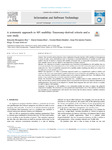A systematic approach to API usability: Taxonomy-derived criteria and a case study

No accesible hasta 9999-99-99
Use este enlace para citar
http://hdl.handle.net/2183/34796Colecciones
- Investigación (FIC) [1654]
Metadatos
Mostrar el registro completo del ítemTítulo
A systematic approach to API usability: Taxonomy-derived criteria and a case studyAutor(es)
Fecha
2018-05Cita bibliográfica
E. Mosqueira-Rey, D. Alonso-Ríos, V. Moret-Bonillo, I. Fernández-Varela, and D. Álvarez-Estévez, "A systematic approach to API usability: Taxonomy-derived criteria and a case study", Information and Software Technology, Vol. 97, Pp. 46-63, May 2018, doi: 10.1016/j.infsof.2017.12.010
Resumen
[Abstract]: CONTEXT. The currently existing literature about Application Program Interface (API) usability is heterogeneous in terms of goals, scope, and audience; and its connection to accepted definitions of usability is rarely made explicit. The use of metrics to measure API usability is focused only on measurable characteristics excluding those usability aspects that are related to the subjectivity of human opinions.
OBJECTIVE. Our objective is to build a comprehensive set of heuristics and guidelines for API usability that is a structured synthesis of the existing literature on API usability but which also covers other aspects that have been neglected so far. This set is explicitly connected with a usability model, something that allows us to check if we are addressing actual usability problems. METHOD. Our approach is to follow a systematic approach based on a comprehensive model of usability and context-of-use. From this comprehensive model we derived the set of heuristics and guidelines that are used to carry out a heuristic evaluation with usability experts and a subjective analysis with users. The influence of the context of use, something that is normally ignored, is explicitly analyzed. RESULTS. Our heuristics and guidelines were integrated into a usability study of a sleep medicine API. In this study, we were able to identify several usability issues of the proposed API that are not explicitly addressed in the existing literature. The context of use helped us to identify those categories that were more relevant to consider in order to improve API usability. CONCLUSION. The literature on API usability is very technically-minded and tends to neglect the subjective component of usability. We contribute to a more global and comprehensive view of the usability of APIs that is not contradictory but complementary with metrics. Our criteria ease the always necessary usability evaluation with human evaluators and users.
Palabras clave
Usability
Usability taxonomies
Usability studies
Application program interfaces
APIs
Sleep medicine
Usability taxonomies
Usability studies
Application program interfaces
APIs
Sleep medicine
Versión del editor
Derechos
©2017 Elsevier B.V. All rights reserved





